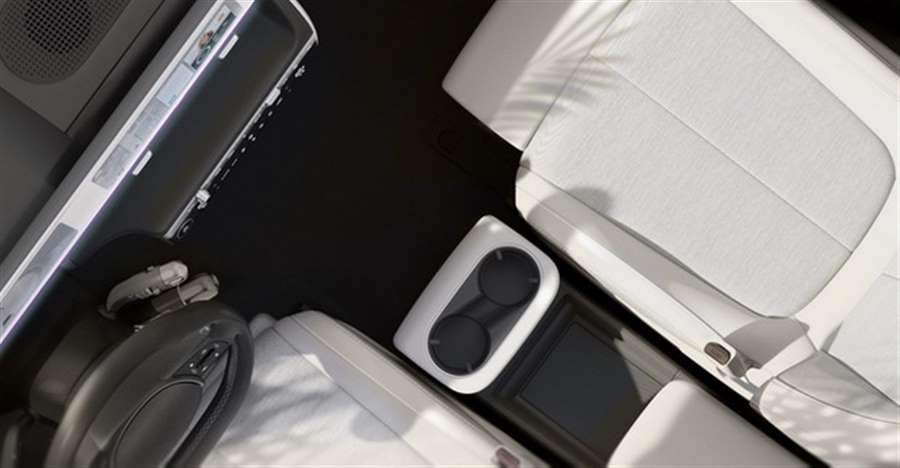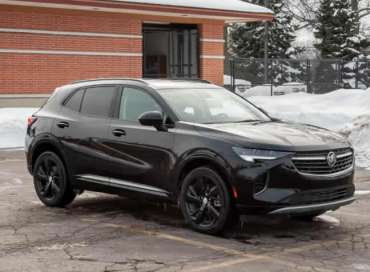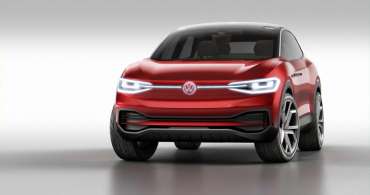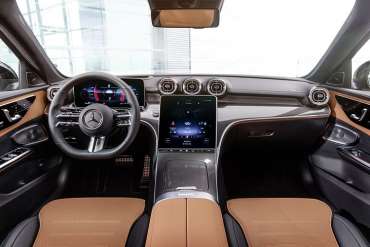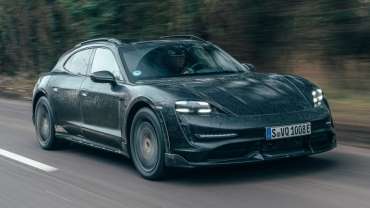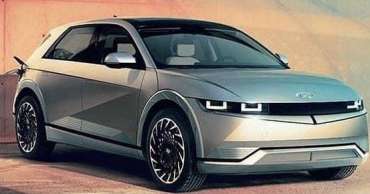
Worldcarblog.com
The Cherokee tribe is asking Jeep to change the name of the off-road vehicle
The well-known vehicle of the American company Jeep "Cherokee", which has been produced for almost 50 years, could soon change its name, since the leader of the American Indian tribe of the same name estimated that the time had come for companies and sports teams in the USA to stop using their name.
Cherokee leader Chuck Hoskins said that he does not tolerate the use of the name "Cherokee", he said that last night he was the spokesman of the tribe for AFP.
Hoskins expressed his position through a video conference on January 29 to the parent company of Jeep, the group Stelantis.
"I think the time has come in this country for companies and sports teams to withdraw the names, images and mascots of American Indians with their products, T-shirts and teams," the Cherokee leader said in a statement published Jan. 14 in the American car magazine Car and Driver. “.
He said that he was sure that it was well-intentioned, but that he no longer does them the honor of seeing his name on a car.
The Jeep company introduced the model of the off-road vehicle "Cherokee" in 1974, after which several models followed.
"The best way to honor us is to learn more about our government, our role in this country, our history, culture, language and to have a constructive dialogue with the tribes recognized by the federal government and their culture," Chuck Hoskins said. .
Under pressure, the American football team and the basketball team from Washington recently changed their name to the American Indians, the Redskins, that is, the Indians.
Americans are facing enormous prices for used cars
The rise in prices of new vehicles has far exceeded overall inflation over the past year. In response, many buyers turned to second-hand, but demand is so powerful, that the prices of these vehicles have jumped even more than is the case with the new one.
The viral pandemic has triggered price hikes throughout the U.S. automotive sector, and for many, both new and used vehicles have become unavailable.
The average price of a new vehicle, according to data from Edmunds.com, reached a record $ 40,578 in the United States, as it jumped by six percent last year.
However, that increase is nothing compared to the prices of used vehicles: The average price of a used vehicle in the United States increased last year by almost 14 percent, 10 times higher than the inflation rate, and reached 23,000 dollars.
The main reason for the rise in prices is economically simple: too few vehicles to sell during the pandemic, and too many customers. The price increase came at a bad time for customers because many have financial difficulties, and others are looking for a car in order to avoid public transport due to the virus, which is also noticeable in Europe.
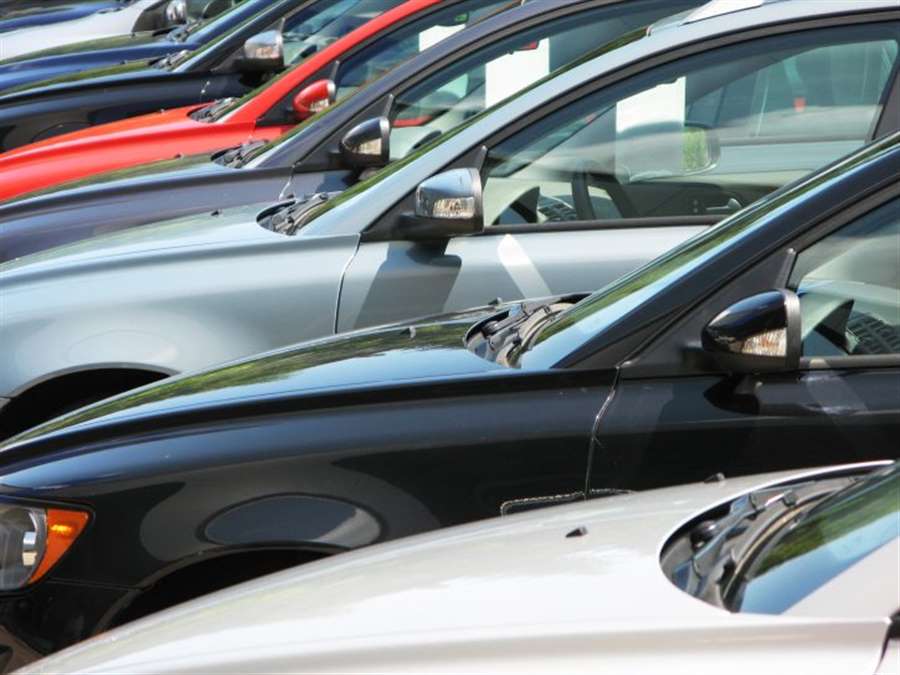
Photo: Shutterstock
Traders and analysts say that high prices could remain or grow even higher in the coming years, because the stocks of new vehicles are small, and the offer of used ones is even smaller.
The shortage began last spring when the coronary virus pandemic began. Carmakers had to close North American factories to try to stop the spread of the infection. That is why the offer of new vehicles dropped, and consequently used ones. And when demand increased late last year, less was available for both.
The shortage has increased as car rental companies and other rental companies and other wholesale car buyers, who are usually the main source of used vehicles, now sell them less. With less travel and fewer people renting cars, and companies and large buyers of vehicles do not buy new ones, and therefore do not sell used as much as before.
The jump in prices has created three classes of car buyers: the wealthy can buy new vehicles, others can only buy used ones, and a third, with low incomes or bad credit, is stuck with older, less reliable vehicles.
The auto industry is still trying to recover from the devastating consequences of the pandemic last spring, when production dropped by 3.3 million vehicles due to the closure of factories. Sales have temporarily dried up, as has the supply of used vehicles.
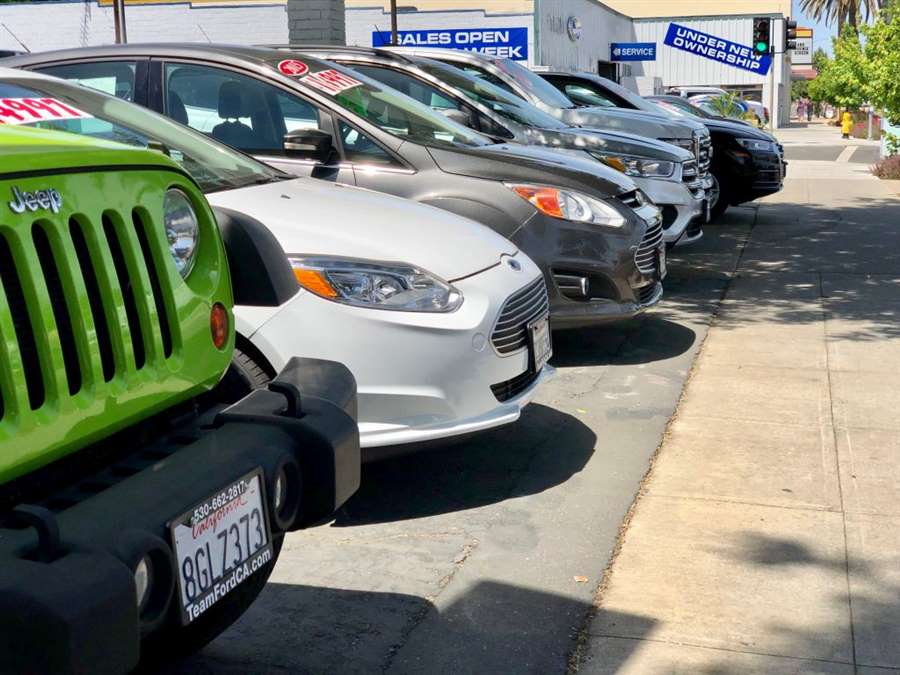
Photo: Shutterstock/ZikG
And when the factories resumed production in May, the demand became higher. The problem was that the supply of vehicles was not sufficient for demand, especially pick-ups and SUVs. Prices have risen, and the purchase of new vehicles during the year fell by almost 2.5 to a total of 14.6 million.
A good example is the case of a buyer from Michigan - in August he went to buy a new pickup and concluded that the price was excessive: more than 70,000 dollars, so he decided on a used Ford F-150 from 2019 with 29,000 miles, and that for $ 37,000, but he also paid seven-year loan insurance.
Even with loans for more than 60 months, the average monthly installment is around $ 500 for new vehicles, which is out of reach for many, but most of the demand for new cars is now more expensive than $ 50,000.
In recent years, carmakers have prepared the ground for higher prices by eliminating a multitude of models cheaper than $ 30,000 because they brought them little profit. They replaced them with SUV models whose price is significantly higher.
Since many buyers have no other options, older vehicles with more than 100,000 miles are now in high demand.
Previously, such old cars were not sold in companies, but since the quality of cars has improved sharply in the past decade, a number of companies are repairing such cars, and even providing credit assistance to customers with lower incomes or bad credit ratings.
If prices remain unaffordable, the door can be opened to a company that could make good money on cheap new cars with only basic equipment. That’s exactly what Korean carmaker Hyundai did to enter the U.S. market a few decades ago.
2021 Buick Envision Review: Premium Value
The verdict: The redesigned 2021 Buick Envision premium compact SUV is stylish and refined, and has easy-to-use tech features, but poor brake-pedal feel degrades the driving experience.
Versus the competition: Sized like a compact SUV but priced below subcompact luxury models, the 2021 Envision gives shoppers who aren’t concerned with having a traditional luxury badge a lot of value for their money.
The 2021 Buick Envision newly shares its platform with the Cadillac XT4 compact luxury SUV, and it’s wider, lower and slightly shorter than the model it replaces. Despite the redesign, it remains one of the few vehicles sold in the U.S. that’s built in China.
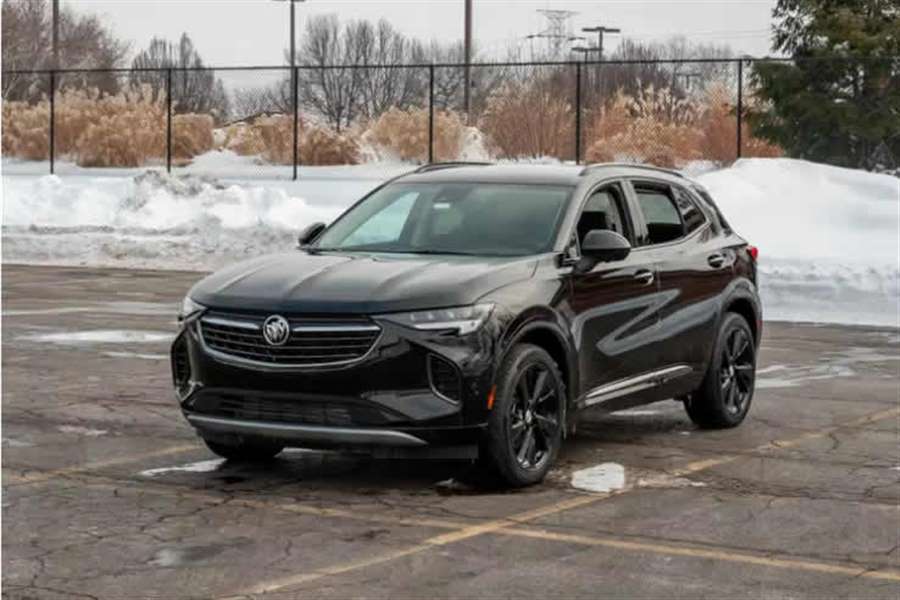
The 2021 Envision is also less expensive than its predecessor; a base Preferred trim level with front-wheel drive starts at $32,995 (including a $1,195 destination charge), which is $1,700 less than the starting price of the 2020 Envision. Our test vehicle was a mid-level Essence trim with front-wheel drive, and its as-tested price of $41,315 included a $2,500 Technology Package and a $1,325 Sport Touring Package, the latter featuring black exterior accents and 20-inch aluminum wheels. All-wheel drive is available on any trim for an extra $1,800.
How It Drives
All Envisions are powered by a 228-horsepower, turbocharged 2.0-liter four-cylinder engine that works with a standard nine-speed automatic transmission. The engine is smooth, refined and delivers adequate acceleration, and it produces a bit of a growl when you really step on the gas pedal. With nine forward gears, the automatic makes frequent upshifts when accelerating from a stop. The shifts are smooth, but there’s a short pause between gear changes. Part- and full-throttle kickdowns, however, happen without delay.
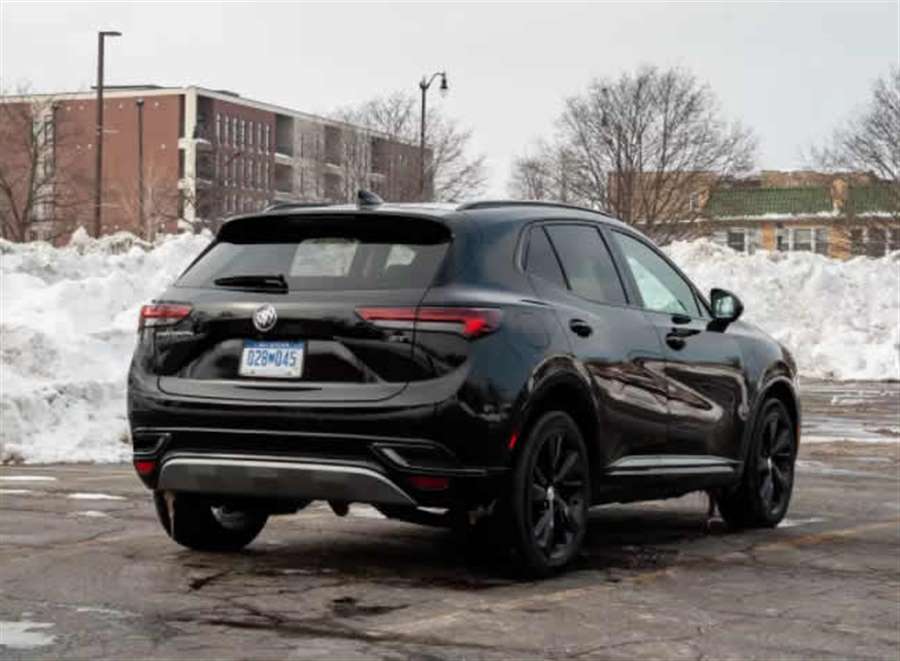
The SUV steers with a light touch, and the suspension deals swiftly with impacts from broken pavement. Body motions are well controlled overall, but the suspension tuning is on the firm side. This was especially noticeable on one stretch of road with small buckles in the asphalt, one after the other, that resulted in a choppy ride. Our test vehicle’s 20-inch wheels and low-profile tires likely didn’t help matters, and it’s possible the standard 18-inch wheels with taller-sidewall tires offer more comfort. Ditto for the top Avenir trim level’s available adaptive suspension, though experience has revealed that advanced suspensions don’t always compensate for large wheels.
The Envision’s brake-pedal feel was disappointing on a number of fronts. Pedal feel is numb, and it suffers from poor linearity on top of that. We’ve experienced this unpleasant combination in certain gas-electric hybrids, but it’s less common in conventionally powered vehicles like the Envision. Like many hybrids and a growing number of conventional vehicles, however, the Envision has a brake-by-wire system with electric assist rather than traditional vacuum-assisted power brakes. (We reported similarly disappointing braking feel in our review of the XT4, the Envision’s platform mate.)
The front-drive Envision is EPA-rated at 24/31/26 mpg city/highway/combined, while all-wheel-drive versions are rated 22/29/25 mpg. More powerful compact luxury SUVs like the Acura RDX and Lincoln Corsair get slightly worse estimated gas mileage, but the smaller BMW X1 has slightly better ratings (see fuel economy estimates for front- and all-wheel-drive versions of these SUVs).
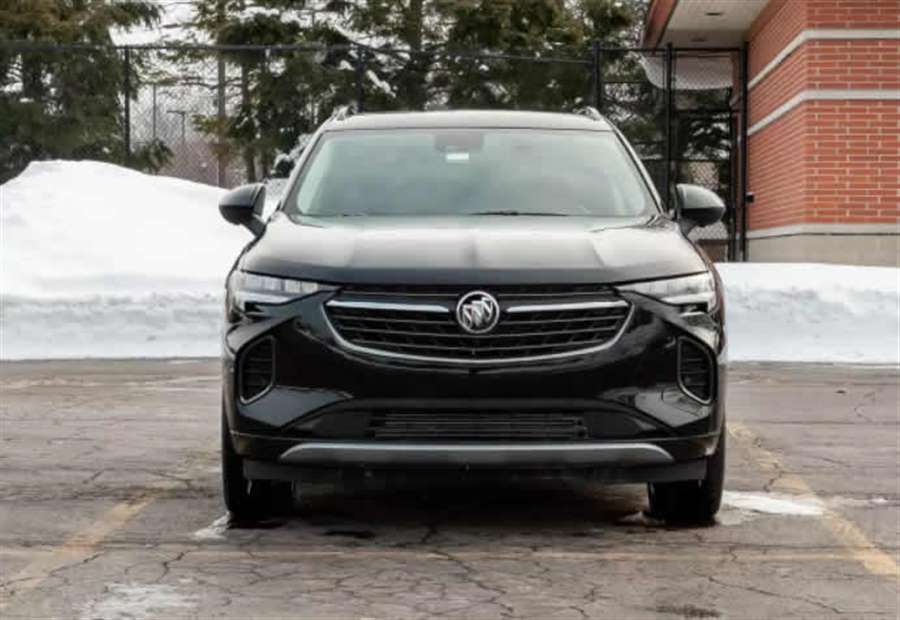
The Interior
Interior quality is good overall with soft-touch surfaces closer to eye level and hard plastic near your feet. Our test vehicle’s all-black color scheme, however, looked a bit dour to my eyes. A beige interior is also offered.
Frequently used controls are within easy reach of the driver, and the center of the dash is dominated by the optional 10.2-inch touchscreen (an 8-inch touchscreen is standard in the Preferred trim). The big screen is responsive, has an intuitive interface and looks great. There are also handy volume and tuning knobs to the left of the screen.
Both touchscreen systems include wireless Apple CarPlay and Android Auto smartphone connectivity, but only the Avenir trim includes wireless device charging. Connecting my iPhone to the multimedia system was easy, and the wireless CarPlay connection seemed just as responsive as the more common wired setup.
One of the more unique elements of the interior is the gear selector, which consists of a column of buttons and pull switches that go where a conventional shifter channel otherwise would. It didn’t take long to get accustomed to the system, but the design doesn’t result in any additional storage space on top of the front center console; there’s a small forward bin, two cupholders to the right of the shifter and a storage bin under the front center armrest. The design does, however, eliminate the obstruction a lever would represent, and its electronic nature allows for an open lower storage area below the console.
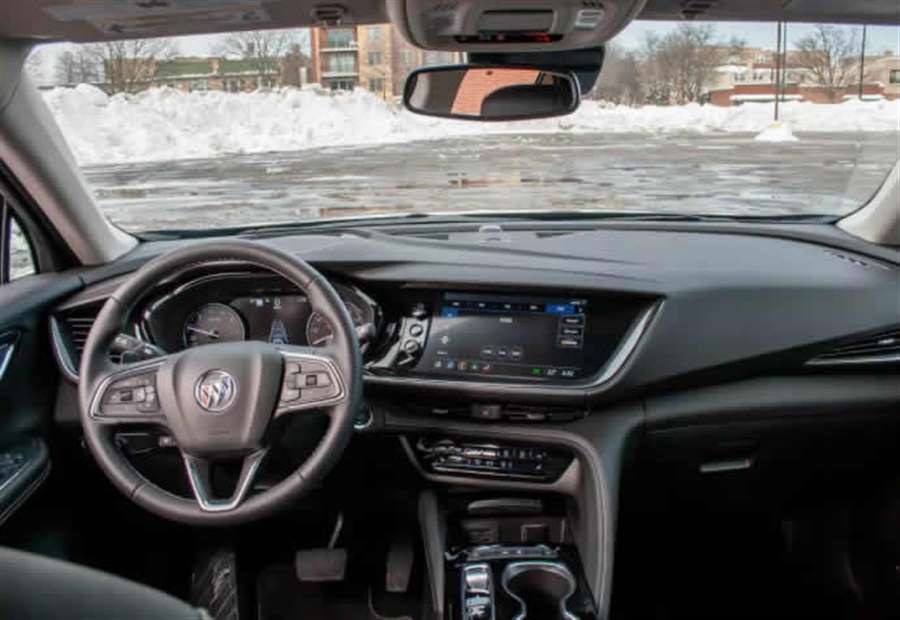
The Envision’s front bucket seats are comfortable, and they’re finished in cloth and simulated leather (Preferred) or perforated real leather (Essence and Avenir). The seats have modest side bolsters that don’t hold you in place when taking a corner quickly, however.
There’s surprisingly good rear-seat space for adult passengers. The bench seat is comfortable and there’s good headroom. The standard 60/40-split backrest folds flat with the cargo floor, extending the luggage area, but the seatback doesn’t recline.
Safety
Neither the Insurance Institute for Highway Safety nor the National Highway Traffic Safety Administration had crash-tested the 2021 Buick Envision as of publication. The list of standard active-safety features includes forward collision warning with automatic emergency braking, blind spot warning with rear cross-traffic alert, lane-keeping assist and automatic high-beam headlights. A head-up display, 360-degree camera system and adaptive cruise control are optional.
Value in Its Class
The Envision doesn’t fit neatly into the mainstream or luxury compact SUV classes, but to hear Buick tell it, that’s an opportunity. Rob Peterson, the brand’s marketing manager, said Buick serves shoppers moving up from mainstream brands and has both the Envision and the smaller and less expensive Encore GX to offer small SUV shoppers.
There are still some mainstream elements like cloth upholstery and manual air conditioning in base Envisions, but the mid-level Essence trim swaps them and more for upscale amenities without significantly ballooning the price tag. It’s a value recipe that seems right for the times.
Volkswagen started producing another electric SUV: ID.5
Production of the first pre-series copies of ID.5 has begun, while the start of production of models intended for the market is expected in the second half of the year. The new model should be reminiscent of the ID.Crozz concept, and it is certainly a coupe version of the already known Volkswagen electric SUV - ID.4.
The German car giant Volkswagen continues with the offensive on the electric car market, so it has already started the production of the third electric model based on the MEB platform, reports zimo.dnevnik.hr.
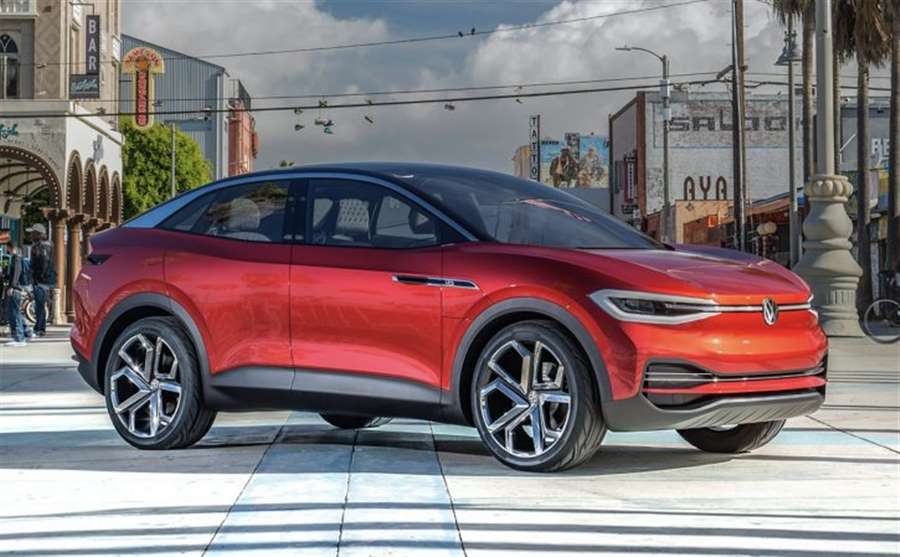
Sales of the ID.3 model (which should play the role of an electric Golf on the market) began last year, followed by the compact ID.4 SUV. Several other models are in preparation, such as the family ID.6, whose photos were recently leaked in China, and which you can see here, and ID.2 is mentioned. However, the first comes next - ID.5, an attractive SUV in the form of a coupe.
As ID.5 is not yet official, there is no data on its performance, but according to rumors, this will be a coupe version of the ID.4 model, which should look like the ID Crozz concept.
Although it has not been officially presented yet, the German company confirmed that the production of pre-series models has already started, while the production of the final versions is expected in the second half of the year.
Interestingly, like the ID.3 model, the "five" will not be intended for the United States, but the primary market will be European.
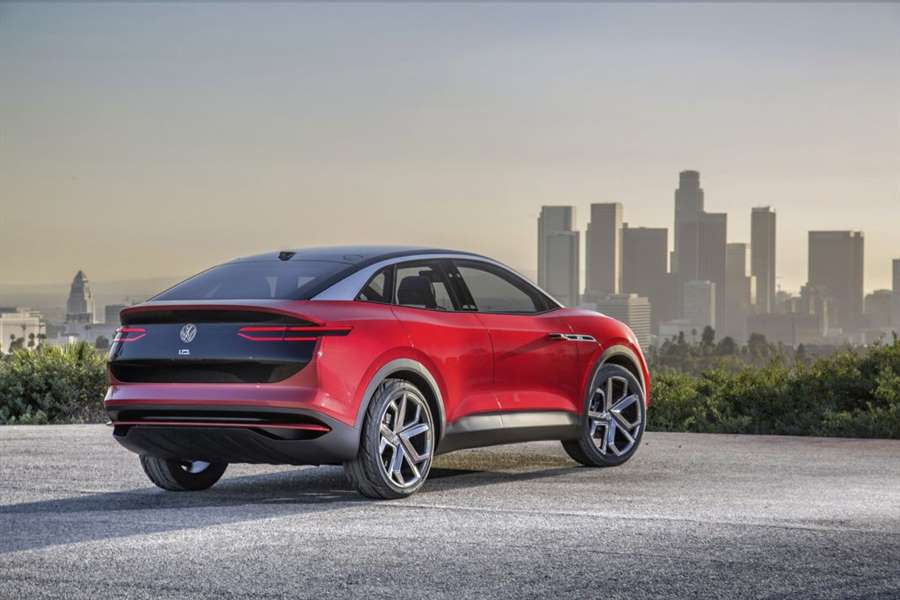
In terms of options and performance, it is speculated that the figures will be similar to those on the ID.4 model. Thus, the 150 kW engine that drives the rear wheels is mentioned (versions with two engines and all-wheel drive will appear later), as well as the 77 kWh battery.
Given that the start of production is expected in the second half of 2021, it is clear that Volkswagen will not wait too long until the official presentation of this model.
Pictures of the concept on which ID.5 is supposedly based indicate that this may be the most attractive electric "Volkswagen" which, if the price is not too high, could really achieve great market success, and perhaps be a bestseller in the e-SUV class. German companies.
New Mercedes-Benz C-Class. He steals technology from the S-Class
Here is the bitterly sweet premiere of Mercedes. One of the most important models on offer has officially said goodbye to big engines. 4 electrified cylinders are the maximum you can count on in the new C-Class. Apart from the engine, it is a really interesting car that in many respects strives for higher market segments.
After 7 years of market presence, we are officially saying goodbye to the fourth generation Mercedes C-Class - the last available with 8 and 6-cylinder engines. Fans of "real" motoring have reason to complain. However, this does not mean that the new C-Class is not a worthy successor to its predecessors. The car promises to be great, especially in terms of equipment and technical solutions.
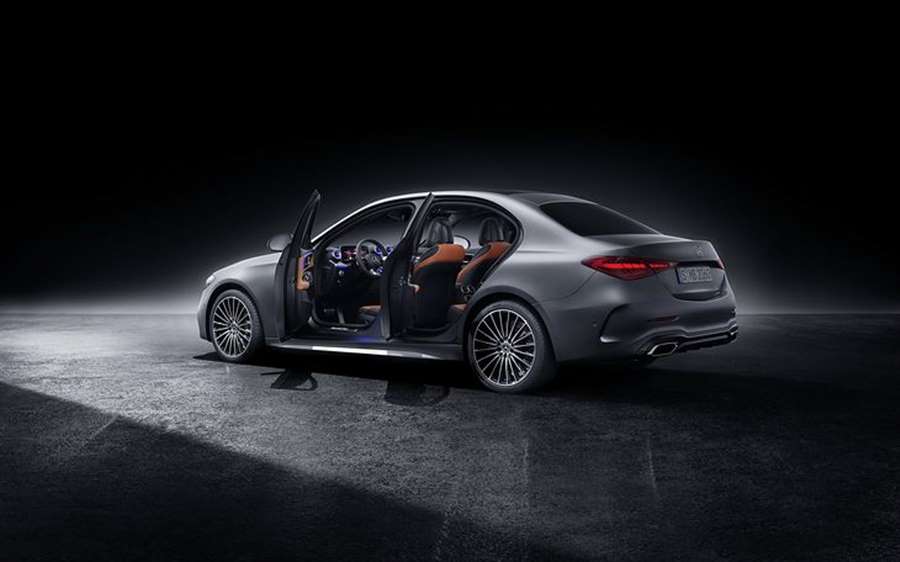
inspired by older siblings…
Looking at the photos, it’s not hard to see a resemblance to the premium S-Class. The new C-Class, although smaller by as much as two segments, is reminiscent of a leading sedan. Moreover, it is not a small car - as usual, the new generation has become bigger than its predecessor.
It is 4,751 mm long, 1,820 mm wide and 1,438 mm high, which is 65 mm longer, 10 mm wider and 9 mm lower. The wheelbase has also increased significantly - from 2,840 to 2,865 mm, which will surely flow into the cabin space. The trunk, however, remained practically the same dimensions - 450 liters in the sedan and 490 liters in the station wagon.
Mercedes boasts that all this has been achieved without compromising the proportions and aerodynamics of the body. The C-Class still boasts an impressive drag coefficient of Cd 0.24 for the sedan and Cd 0.27 for the station wagon.
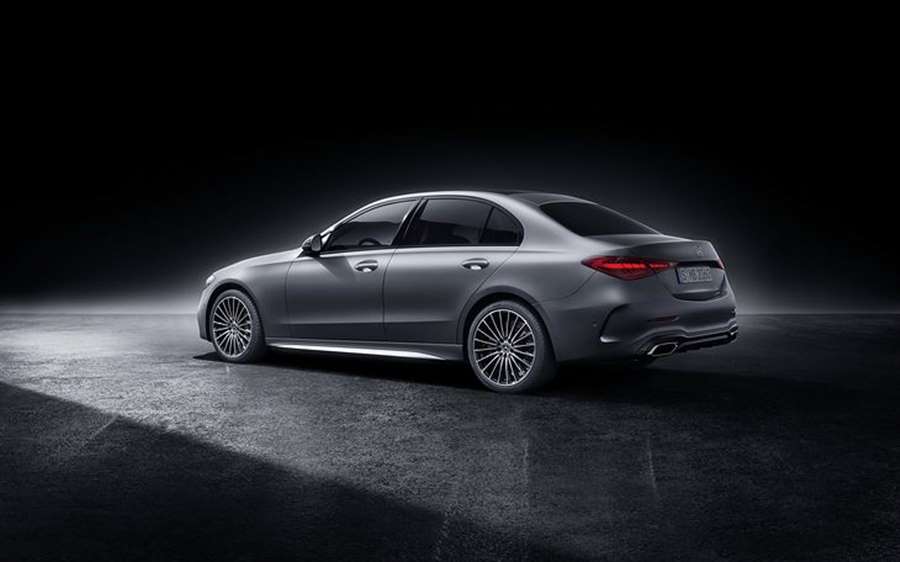
The cockpit will probably come as no surprise to those already familiar with Mercedes ’modern philosophy. Almost all services are based on large screens, which are also reminiscent of those in the S-Class. However, they are somewhat smaller. The one in front of the driver has a standard diagonal of 10.25 inches (and optionally 12.3). In turn, the central, vertically positioned measures “only” 9.5 inches with the possibility of replacing 11.5 inches.
Of course, there is the latest version of the MBUX system with voice control and many intelligent functions that support the driver and passengers while traveling. Constant connection to the Internet will provide not only contact with the world and access to current information, but also, for example, streaming services, including the original music collection provided by the manufacturer. Remote software updates will also be standard.
Manageability without sacrificing comfort
The system known from the aforementioned S-Class debuts in the new C-Class, although in a slightly simplified version it will certainly prove useful. We are talking about swivel rear wheels, which can change their position by 2.5 degrees if necessary, improving handling at low speeds and increasing rear stability at high speeds.
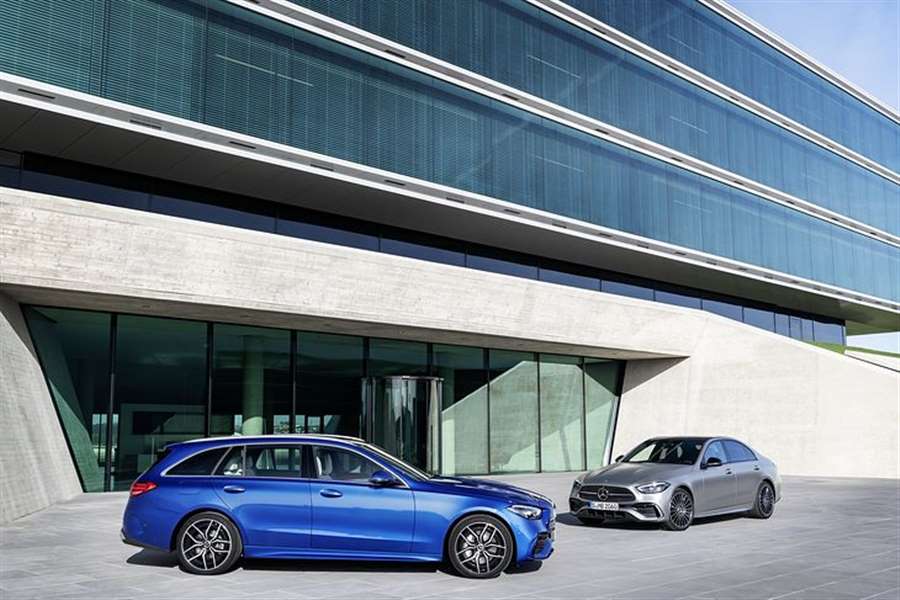
This solution made it possible to reduce the turning radius by 43 cm. It is also the cause of a shortened management ratio. Of course, as an option, an adjustable suspension will also be available that adapts the suspension to current road conditions.
Digital Light headlights seem to be another interesting novelty. You won't guess - we already know them from the S-Class. It is an optional solution that uses 1.3 million micro mirrors to direct the light beam anywhere and to display useful lighting, such as lines or symbols on the road. All this to ensure optimal lighting of the area in front of the vehicle without dazzling other road users.
The equipment can be really rich, far above the standards of the middle class. Massage seats or aroma diffusers in the interior go hand in hand with extensive driver support systems that reduce driver participation in driving even when driving at 210 km / h.
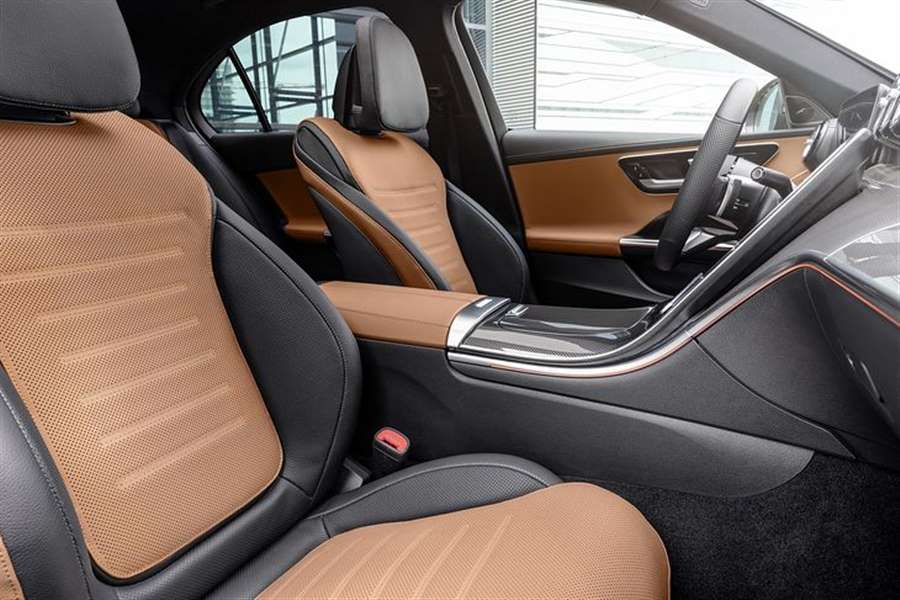
Revolution in operation
This is a change that certainly won’t appeal to everyone. Officially, all engines in the new C-Class have 4 cylinders and a volume of no more than 2 liters. Moreover, each motor is supported by a mild hybrid system that allows it to recover energy, which is then used to temporarily improve performance or power the built-in instruments. Plug-in hybrids are also available.
The role of the basic version of the engine is performed by the petrol C 180 1.5, available in 170 and 204 hp variants. Then we have a two-liter C 300 258 hp and two diesels: a C 220 d 200 hp and a C 300 d 265 hp. A mild hybrid is standard on each of these engines, as is a 9-speed automatic transmission. The C 200 and C 300 versions will also offer the optional 4Matic 4WD drive.
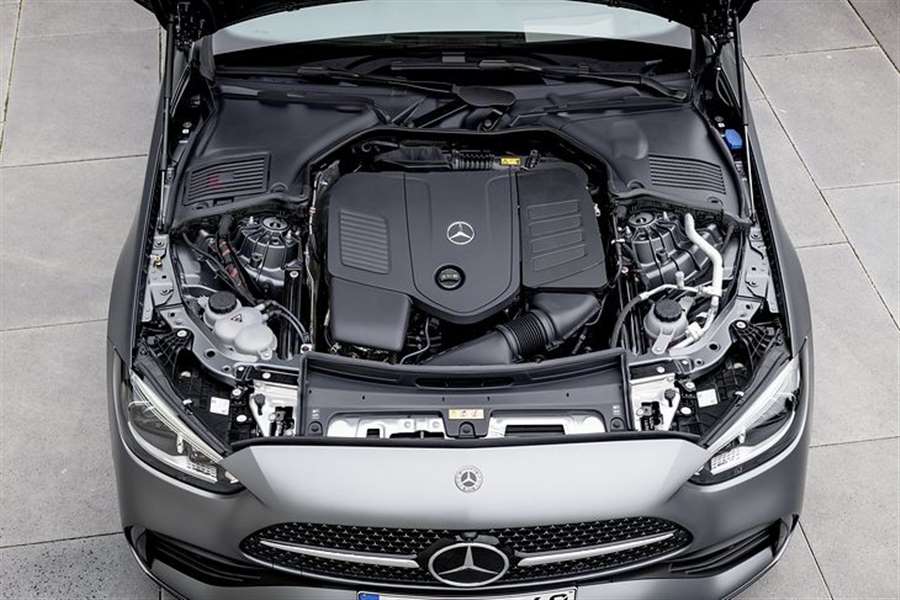
There are also plans for plug-in hybrids based on gasoline and diesel engines. And although Mercedes has yet to boast the specifications of any of these drives, we know what their main attraction will be. We are talking about an additional electric motor that generates a maximum of 129 hp of power and an impressive 440 Nm of maximum torque.
As befits, they will only be able to travel on electricity. Thanks to the 25.4 kWh battery, the maximum range on electricity alone will be up to 100 km. The result is currently unattainable for the vast majority of competitors.
Another advantage is the ability to quickly charge with 55 kW, which allows you to charge the battery in 30 minutes.
Will the risk pay off?
The new C-Class seems to have a number of advantages, and while the decision to abandon large engines may not appeal to everyone, the car should strengthen its position in the premium mid-range. In any case, Volvo is the best example of how "downsizing" bothers commentators on forums more than actual customers.
Will it be the same for Mercedes? We'll find out soon enough. The first copies will be delivered to customers in the summer of 2021.
New Porsche Taycan Cross Turismo prototype review
We get behind the wheel of a prototype version of the new all-electric Porsche Taycan Turbo S Cross Turismo ahead of its official arrival
Porsche’s first foray into the electric car world has gone better than it could’ve imagined. The Taycan has won plaudits the world over, with sales to match. So it makes sense to follow up on the success quickly with the second version of the Taycan, the Cross Turismo.
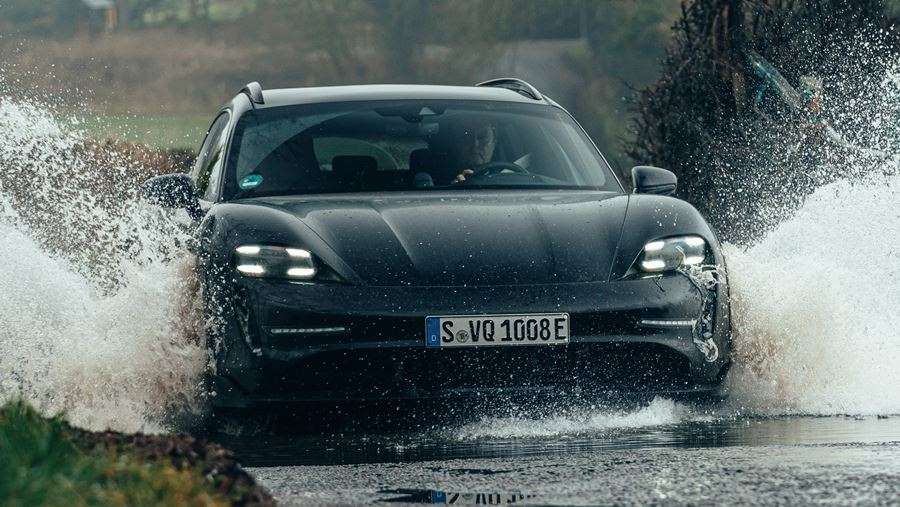
The Porsche Taycan Cross Turismo is set to be unveiled next week, but Auto Express was invited to put a pre-production model through its paces in the UK, weeks before the very car would be unveiled on stage.
There was an added twist to this car – it was in the middle of a world tour taking in the US and the rest of Europe before being taken back to Germany. And although it wore a light disguise, it wasn’t to be cleaned during its trip. So joining the Californian sand was a fair bit of Buckinghamshire mud from our own test drive.
The Cross Turismo features the running gear and much of the bodywork at the front end from the Taycan saloon, but the roof has been extended which, along with the muscular rear three-quarter bodywork, flows into a hatchback tailgate in a very similar way to the Panamera Sport Turismo.
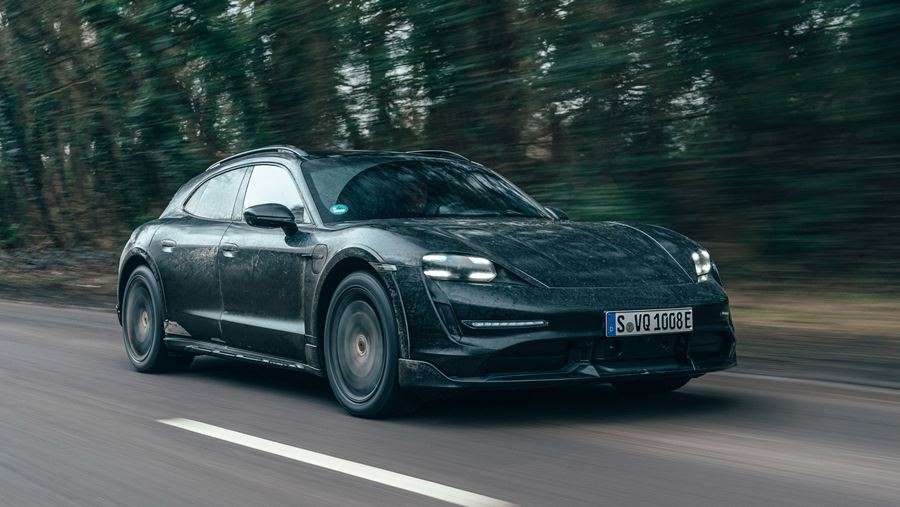
Even behind the dirt and disguise, it’s clear what the car is – as one Panamera Sport Turismo owner spotted on our test drive. He also found out how quick the car is.
Full specs will be revealed on March 4, but the Turbo S model we’re driving uses the same electric motors (delivering 751bhp and 1,050Nm) and 93kWh battery as it’s Taycan equivalent. That means brutal acceleration with an estimated 0-62mph time of just 3.0 seconds, 0-100mph in 6.5 seconds and on to a top speed of around 160mph.
Those figures are slightly down on the saloon, but you’d hardly notice. Even in Normal mode, adjusted by a dial on the steering wheel or via the crystal clear touchscreen, a flex of your right foot will shove you back in your seat as the whine from the electric motors ramps up.
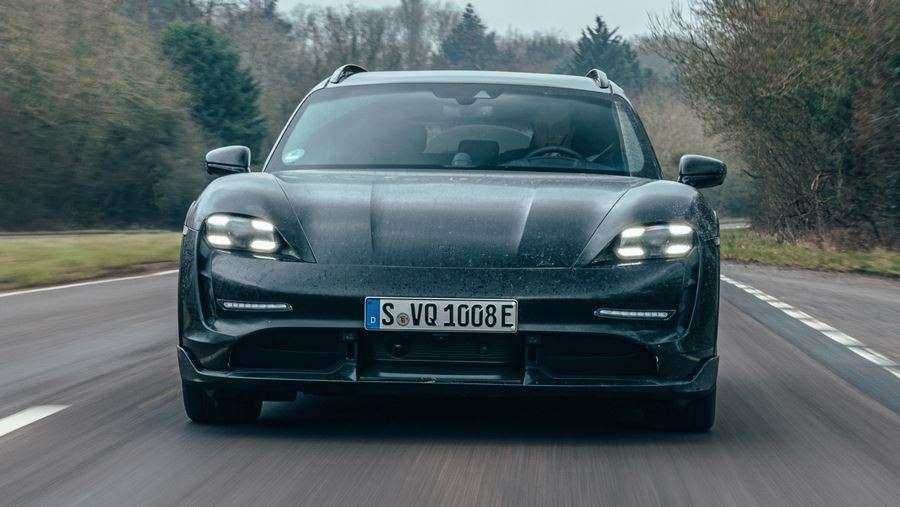
You can choose an electronically generated sound that’s a little like a space ship as part of the Electric Sport Sound pack. It comes on automatically if you select Sport or Sport Plus modes – they also sharpen up responses from the steering, throttle and suspension.
The Cross Turismo has a bit of SUV attitude, too, with Gravel mode, which raises the suspension by 10mm in addition to the 20mm the Cross Turismo gets over the standard Taycan. It doesn’t turn the car into an off-roader, but it does give you a little more confidence to take to a dirt track or tackle a deep ford, as we did.
Four-wheel drive helps, too, but the Taycan has always felt like a proper Porsche to drive; nimble and incredibly responsive for something of its size and weight.

It also rides in a way that we’ve come to expect from Porsche, but which seems to defy physics. Even in the most hardcore modes, you can live with the ride. But for everyday driving in the Normal setting – or Range if you want to try and get close to an expected 250-mile range – it’s almost limo-like, while you’re still able to enjoy the most direct steering yet in an EV and super-tight body control. The best bet is to go for your own blend of settings in Individual mode, but you can throw the car around with confidence and blast out of corners with acceleration that little else can match.
The (fast) limo experience extends to the back where the added ride height makes access a little easier, but it’s best to describe it as snug – more due to the high window line than a lack of space.
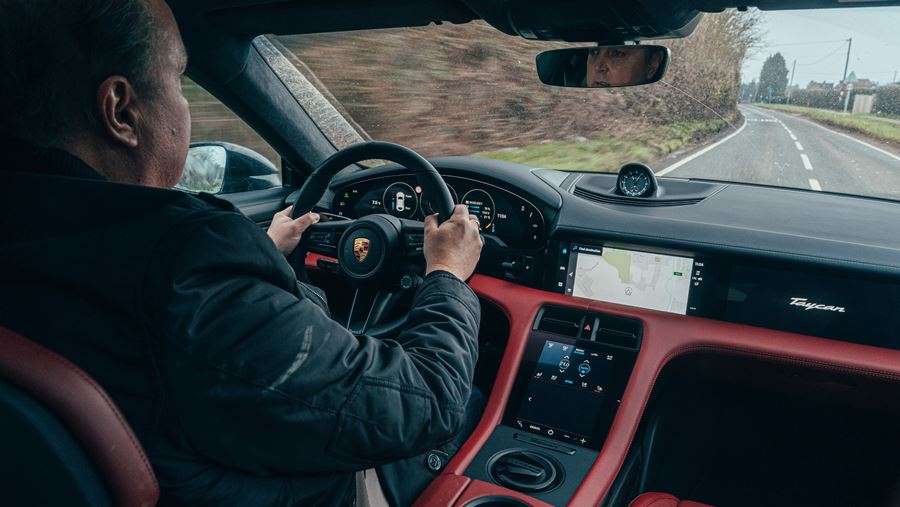
Similarly, style compromises the boot. Again, the hatch improves access, but the sloping rear screen will limit load carrying and won’t endear you to your dog.
Although this was a pre-production model, there was nothing pre-production about the build quality. Porsche cabins are as good as they get these days, with strong tech that includes a digital instrument display, two central touchscreens and even one in front of the passenger. The only rattles from this well-travelled pre-prod model came from grit coming lose from under the car – it felt incredibly solid.
One difference on our pre-production test example was the wheels – you’ll get 21-inches on production cars, ours came on 20s, wisely fitted with all-season tyres.
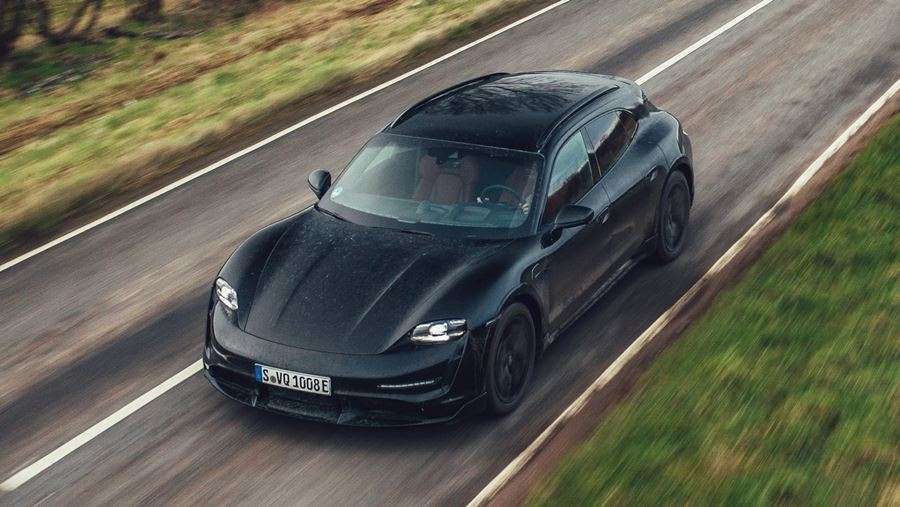
Although the Taycan Cross Turismo gives you plenty more than the saloon, we’re not expecting that to be reflected in the price – we reckon around £140,000 for the range-topping Turbo S – no more than a couple of grand more than its sibling. The rest of the Cross Turismo range should follow the saloon, with the exception that a rear-wheel drive version is not expected.
That won’t bother too many. Our short run in this rather special pre-prod model has proven Porsche will have yet another hit on its hands.
Hyundai IONIQ 5 - World Premiere
Welcome to the world premiere of the Hyundai IONIQ 5. The latest EV that redefines the way of life in electric mobility and allows you to start your own world.
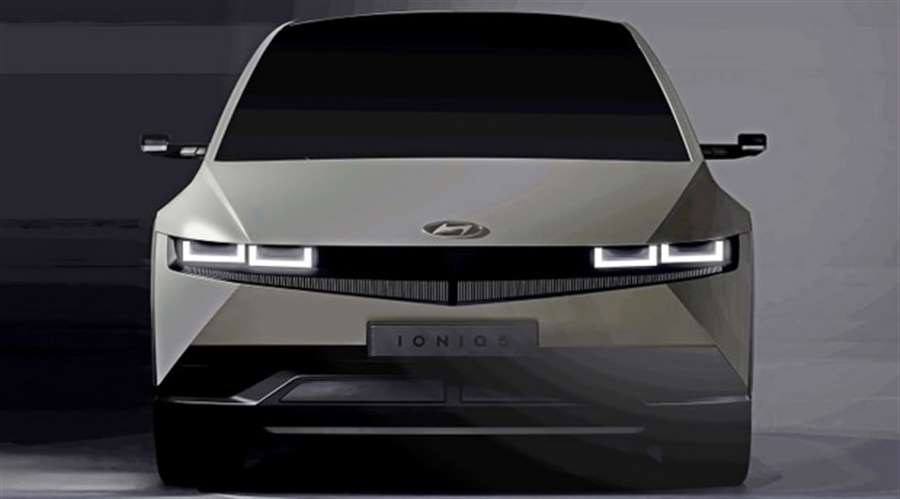
IONIQ 5 satisfies different lifestyles without restrictions in your daily life. EV combines adaptable space and environmentally friendly materials with outstanding technology and design. IONIQ 5 takes us to a better, brighter and more sustainable world.
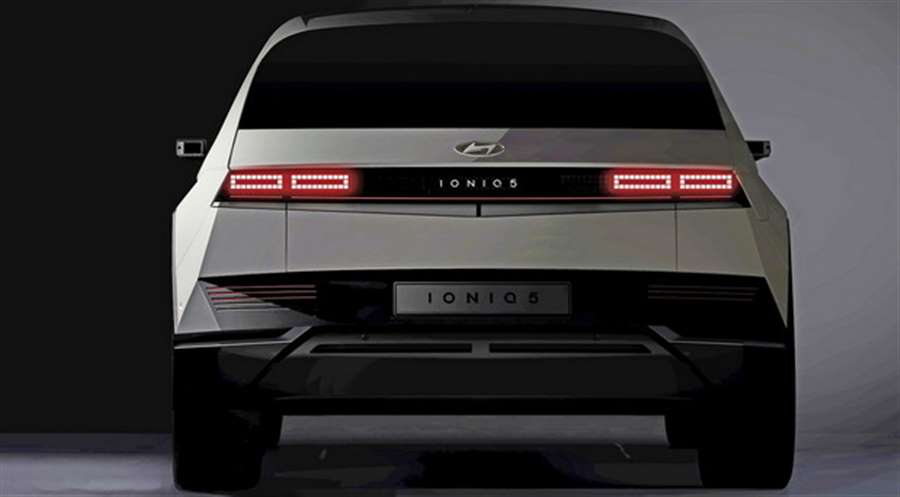
Join us on February 23rd for the world digital premiere of the all-new IONIQ 5.
